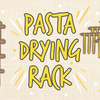Pasta Vs. Noodles: The Ultimate Guide

Pasta and noodles have been around for over 1000 years, but the differences between these two can only be described in terms of ingredients, taste, and texture. Whereby pasta only futures durum wheat, salt, and water as the primary ingredients, while noodles require at least 5.5% egg solids as part of the ingredients as per the National Pasta Association. This guide will dive into all the relative differences between pasta and noodles, their health benefits, and how to consume each variety. Further reading material: link.
Not Much Time? Skip To What You'd Like To Learn...
-
WHAT IS PASTA?
-
WHAT ARE NOODLES?
-
DIFFERENCE BETWEEN PASTA AND NOODLES
-
COMMON VARIETIES OF PASTA AND NOODLES
-
NUTRIENT COUNT
-
ALTERNATIVES OF NOODLES AND PASTA
-
Common Questions
What Is Pasta?
Pasta is an Italian dish consisting of dough that’s prepared using durum wheat and water. The dough gets extruded or stamped into the required shapes and can be cooked by boiling it in water. Pasta can be divided into two major categories: dried and fresh pasta. Dried varieties are produced and dried commercially via the extrusion process. New varieties, on the other hand, are prepared by hand as per the traditional recipe. Further reading material: healthline.com.
What Are Noodles?
Noodles are very thin and long strips of pasta that are often prepared using unleavened dough mixed with eggs before getting rolled and cut into strips. Noodles are best consumed in a sauce or with soup. Noodles typically require less time to prepare compared to pasta as all you have to do is boil them in water or deep-fry. Further reading material: healthline.com.
Difference Between pasta And Noodles
Origin
Noodle Origin - The origin of noodles is believed to be modern-day Palestine among the Arabs around 4000 years ago. However, it’s thought that the various varieties of noodles are as a result of originating from different cultures where certain ingredients were more predominant than others. The regions of modern-day Eastern Asia have a deep history with noodles whereby a book dating back to 220 CE contains records of noodles that were prepared using the millet floor.
Pasta Origin - While it’s commonly believed that pasta is of Italian origin, the earliest varieties of pasta were actually a likely descendant of Asian noodles. The central Asia region is, in fact, believed to have produced the first pasta varieties more than 3 thousand years ago. Pasta is believed to have spread to the rest of the world during the nomadic Arab trade, which relied on the Mediterranean Seaways from Asia. Further reading material: pbs.org
Which Came First?
Pasta is entirely based on ancient noodles, so it’s true to say that noodles came first as per the current empirical evidence.
Ingredients
Pasta Ingredients - While the recipe for standard pasta will often change depending on the variety and from one region to the other, the primary ingredients will always be durum wheat flour, water, and sometimes eggs are also added.
Noodle Ingredients- Noodles can be prepared from a broader range of ingredients compared to pasta. As a result, noodles can be divided into four major varieties: wheat, rice, buckwheat, and eggs based noodles. Other less common types also use corn soup, mung beans, potato starch, and even seaweed as the primary ingredients.
How To Eat
Pasta - Due to its neutral flavor and texture, pasta can be used with a wider range of dips, sauces, soups, and even salads. Meat-based sauces, which are often thick, will adhere perfectly with any pasta variety, while tomato-based sauces will give the pasta the [perfect taste notes.
Noodles - There’s no limit to how you can enjoy your noodles, from baked casseroles to soups and sauces. Chilled noodles can also be served cold in a salad, while freshly cooked noodles are best served with dipping sauce or a thick soup.
Common Varieties Of Pasta And Noodles
Pasta
1. Macaroni
Macaroni is dry pasta that’s shaped like narrow tubes that are cut in short lengths and have a slight curve. Macaroni has an absorbent surface that easily adheres to thick sauces and is often served with cheese and tomato-based sauces.
2. Rigatoni
Rigatoni is tube-shaped pasta that comes in varying diameters and lengths and is originally from Italy. Rigatoni characteristically has ridges along the entire length and depending on the manufacturer. They may also have swirling patterns around the tubes of pasta. The adhesive surfaces of rigatoni make better surfaces for grated cheese and sauces.
3. Fusilli
Fusilli or rotini is a twisted pasta variety that’s originally from Italy. Fusilli is formed into helical or corkscrew shapes by rolling a small rod over pasta strips, thus winding them around it in a corkscrew shape. Fusilli is available in both whole-wheat varieties and colored varieties, which require additional flavorings such as beetroot and tomato for red colors and spinach for green color. Fusilli is best consumed with smooth sauces such as pesto.
4. Linguine
Linguine is prepared using wheat flour, eggs, and water making it similar to fettuccine with an elliptical shape and was traditionally served with sauces such as pesto. Linguine can also match with fish and tomato-based sauces. Linguine is available in both whole wheat and white flour versions, but the original recipe relied on durum wheat.
5. Spaghetti
Spaghetti is a long and thin cylindrically shaped pasta that’s originally from Italy. Spaghetti is prepared using milled wheat flour or semolina and water. Using refined flour results in white pasta, but whole wheat flour can also be used. Spaghetti can match with an entire range of dishes such as sardines, cottage cheese, prawn, tomatoes, and just about any meal based sauce.
Noodles
1. Cup Noodles
Cup noodles are a brand of instant cup noodle ramen that was invented in 1971. A single cup of noodles includes a single serving of noodles that are packaged in a foam food container or a paper/plastic cup. These often come in various flavors ranging from beef to chicken and even mushrooms.
2. Fried Noodles
Fried noodles rely on either stir-frying or deep-frying as a means of preparation, depending on the recipe. This variety is often crunchy and is best served with thick sauces and meat-based soups together with vegetables.
3. Rice Noodles
Rice noodles are prepared using rice grain flour, which gives the noodles a gelatinous texture making them somewhat chewy. Rice noodles are most common in Southeast Asia cuisines and are often served alongside beef and crab meat.
4. Instant Noodles
Instant noodles are sold in a precooked state whereby the dried block that’s already flavored gets packed in an airtight seal. Instant noodles are often prepared using wheat flour, palm oil, salt, and additional seasoning ingredients, which vary from one brand to the other.
Nutrient Count
Which Has More Carbs?
While pasta and noodles almost have the same amount of calories, plain cooked noodles have 26 g of carbs per 100 g compared to pasta’s 25 g per 100 g serving size.
Which Has More Protein?
Plain cooked noodles have more protein content compared to plain cooked [pasta due to the additional egg content used in preparing noodles. A 100 g serving of plain noodles has 6 g of protein compared to 4 g of protein from a similar serving amount of pasta.
Which Is Healthier?
Both past and noodles can be perfectly healthy meals when consumed in moderation due to their high starch content. However, noodles have more ingredients, thus having more nutrients compared to pasta. Further reading material: link.
Alternatives Of Noodles And Pasta
- Zucchini
- Rice Noodles
- Shirataki Noodles
- Black Bean Pasta
- Quinoa Pasta
- Squash Noodles
Further reading material: healthline.com.
Common Questions
Are Noodles Spaghetti?
Yes, spaghetti is a variety of cylindrical noodle pasta.
Is There A Difference Between Pasta And Noodles?
Yes, the main difference between pasta and noodles is in terms of primary ingredients and their effect on the flavor.
Which Is Healthier Pasta Or Noodles?
Noodles are considered to be healthier by a negligible amount compared to pasta.
Why Is Pasta Called Noodles?
Pasta is often called noodles due to its origin in ancient noodle varieties.
Can Pasta Be Used As Noodles?
Some pasta varieties can be used as noodles depending on the specific recipe.
Are Chinese Noodles The Same As Pasta?
No, Chinese noodles contain extra ingredients compared to standard pasta.
Is Eating Pasta Healthy?
As long as it’s eaten in moderation, pasta can be a healthy meal full of proteins and carbs to energize you throughout the day.
Why Are Noodles So Bad For You?
Noodles are considered to be unhealthy when consumed in large amounts due to their high starch content, which can lead to weight gain.
Are Noodles Like Spaghetti?
Yes, although they have a much smaller diameter size and include more ingredients for a more complex taste.






